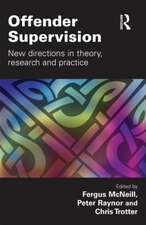Correctional Counseling and Treatment
Autor Peter C. Kratcoskien Limba Engleză Hardback – 7 feb 2024
The volume is broken down into three sections:
- Correctional Counseling and Treatment: Past and Present
- The Diverse Roles of Counselors in Correctional Treatment
- Treatment Methods Used in Corrections
| Toate formatele și edițiile | Preț | Express |
|---|---|---|
| Paperback (1) | 473.16 lei 6-8 săpt. | |
| Springer International Publishing – 28 iul 2018 | 473.16 lei 6-8 săpt. | |
| Hardback (2) | 568.56 lei 3-5 săpt. | +27.15 lei 5-11 zile |
| Springer International Publishing – 17 mai 2017 | 568.56 lei 3-5 săpt. | +27.15 lei 5-11 zile |
| Springer Nature Switzerland – 7 feb 2024 | 651.34 lei 6-8 săpt. |
Preț: 651.34 lei
Preț vechi: 766.28 lei
-15% Nou
Puncte Express: 977
Preț estimativ în valută:
124.65€ • 129.66$ • 102.91£
124.65€ • 129.66$ • 102.91£
Carte tipărită la comandă
Livrare economică 14-28 aprilie
Preluare comenzi: 021 569.72.76
Specificații
ISBN-13: 9783031517402
ISBN-10: 3031517407
Ilustrații: XXIII, 367 p. 5 illus.
Dimensiuni: 155 x 235 mm
Greutate: 0.72 kg
Ediția:7th ed. 2024
Editura: Springer Nature Switzerland
Colecția Springer
Locul publicării:Cham, Switzerland
ISBN-10: 3031517407
Ilustrații: XXIII, 367 p. 5 illus.
Dimensiuni: 155 x 235 mm
Greutate: 0.72 kg
Ediția:7th ed. 2024
Editura: Springer Nature Switzerland
Colecția Springer
Locul publicării:Cham, Switzerland
Cuprins
Part I. .- 1. The Scope and Purposes of Correctional Treatment.- 2. Applying Restorative Justice Models in the Correctional Process.- 3. The Criminal Justice System in Transition: Assisting Victims of Crime.- Part II. The Diverse Roles of Counselors in Correctional Treatment.- 4. Continuity and Change in the Roles of Correctional Personnel.- 5. Treatment of Juvenile Offenders: Diversion and Formal Processing.- 6. Diverting Special Categories of Offenders to Community Treatment Programs.- 7. The Functions of Classification and Assessment Models in Correctional Treatment.- 8. Community-Based Sanctions: Probation and Post-release Supervision.- 9. Community Residential Treatment and Institutional Treatment.- Part III. Treatment Models Used in Corrections.- 10. The Interview: A Basic Tool Used in Correctional Counseling and Treatment.- 11. Behavior Modification Programs Used in Corrections.- 12. Group Counseling in Corrections.- 13. Brief Therapy and Crisis Intervention.- 14. Cognitive Behavioral Therapies Used in Correctional Treatment.- 15. Future Perspectives on Counseling and Treatment of Criminal and Delinquent Offenders.
Notă biografică
Bio Peter Charles Kratcoski earned a PhD in sociology from the Pennsylvania State University, University Park, Pennsylvania, a MA in sociology from the University of Notre, South Bend, Indiana, and a BA in sociology from King’s College, Wilkes-Barre, Pennsylvania. He was selected for several postdoctoral grants by the National Science Foundation. He taught at the College of St. Thomas, St. Paul, Minnesota, and at the Pennsylvania State University before assuming the position of assistant professor of sociology at Kent State University, Kent, Ohio in 1969. He retired as professor of criminal justice studies and chair of the Department of Criminal Justice Studies at Kent State University, Kent, Ohio, where he is currently a professor emeritus and adjunct professor. He has published many books, chapters in books and journal articles in the areas of juvenile delinquency, juvenile justice, international policing, crime prevention, corrections, and victimology. His most recent writing andresearch have focused on juvenile delinquency, juvenile justice, collaborative policing, correctional counselling, financial crimes, corruption and fraud, and victimization of the elderly.
Textul de pe ultima copertă
This book provides a comprehensive overview of the effective methods used in the criminal justice system in the United States to counsel and treat offenders. This new edition outlines innovative approaches to counselling and treatment that focus on recent developments that present new challenges to those practitioners engaged in counselling and treating of criminal and delinquent offenders.
The volume is broken down into three sections:
The volume is broken down into three sections:
- Correctional Counseling and Treatment: Past and Present
- The Diverse Roles of Counselors in Correctional Treatment
- Treatment Methods Used in Corrections
Caracteristici
Includes a comprehensive overview of correctional counselling and treatment programs Features practical application methods, tools, and suggestions Special chapters address emerging and increasing problems; with a focus on both victims and offenders
Recenzii
“This book discusses treatment modalities that are used in correctional settings both community and institutional. … This book is well written by experts in the field, and addresses both children and adults. It explores the major treatment modalities in corrections today. Students will benefit greatly from this book.” (Gary B. Kaniuk, Doody’s Book Reviews, September, 2017)












